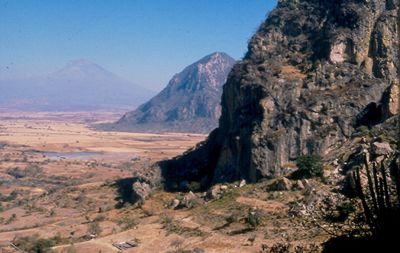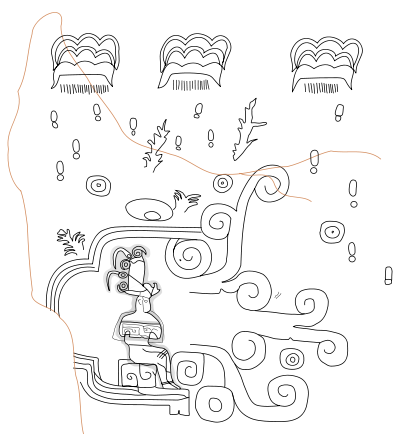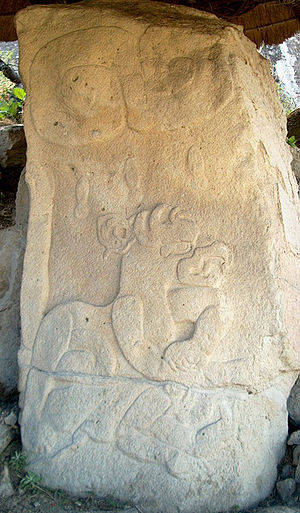
Chalcatzingo
Encyclopedia

Mesoamerica
Mesoamerica is a region and culture area in the Americas, extending approximately from central Mexico to Belize, Guatemala, El Salvador, Honduras, Nicaragua, and Costa Rica, within which a number of pre-Columbian societies flourished before the Spanish colonization of the Americas in the 15th and...
n archaeological site in the Valley of Morelos
Morelos
Morelos officially Estado Libre y Soberano de Morelos is one of the 31 states which, with the Federal District, comprise the 32 Federal Entities of Mexico. It is divided in 33 municipalities and its capital city is Cuernavaca....
dating from the Formative Period of Mesoamerican chronology
Mesoamerican chronology
Mesoamerican chronology divides the history of pre-Columbian Mesoamerica into several periods: the Paleo-Indian , the Archaic , the Preclassic , the Classic , and the Postclassic...
. The site is well-known for its extensive array of Olmec
Olmec
The Olmec were the first major Pre-Columbian civilization in Mexico. They lived in the tropical lowlands of south-central Mexico, in the modern-day states of Veracruz and Tabasco....
-style monumental art and iconography. Located in the southern portion of the Central Highlands of Mexico
Mexico
The United Mexican States , commonly known as Mexico , is a federal constitutional republic in North America. It is bordered on the north by the United States; on the south and west by the Pacific Ocean; on the southeast by Guatemala, Belize, and the Caribbean Sea; and on the east by the Gulf of...
, Chalcatzingo is estimated to have been settled as early as 1500 BCE
Common Era
Common Era ,abbreviated as CE, is an alternative designation for the calendar era originally introduced by Dionysius Exiguus in the 6th century, traditionally identified with Anno Domini .Dates before the year 1 CE are indicated by the usage of BCE, short for Before the Common Era Common Era...
. The inhabitants began to produce and display Olmec-style art and architecture around 900 BCE. At its height between 700 BCE and 500 BCE, Chalcatzingo's population is estimated at between five hundred and a thousand individuals. By 500 BCE it had gone into decline.
The Chalcatzingo center covers roughly 100 acre (0.404686 km²). It was well-situated in a fertile plain, at the basse of two tall hills, Cerro Chalcatzingo and Cerro Delgado. Cerro Chalcatzingo has evidence of long regard and use as a site of ritual significance.
The climate in Morelos is generally warmer and more humid than the rest of the Highlands. A spring rising at the base of the hills provided a source of drinking water for the population.
Chalcatzingo connected trade routes between Guerrero
Guerrero
Guerrero officially Estado Libre y Soberano de Guerrero is one of the 31 states which, with the Federal District, comprise the 32 Federal Entities of Mexico. It is divided in 81 municipalities and its capital city is Chilpancingo....
, the Valley of Mexico
Valley of Mexico
The Valley of Mexico is a highlands plateau in central Mexico roughly coterminous with the present-day Distrito Federal and the eastern half of the State of Mexico. Surrounded by mountains and volcanoes, the Valley of Mexico was a centre for several pre-Columbian civilizations, including...
, Oaxaca
Oaxaca
Oaxaca , , officially Estado Libre y Soberano de Oaxaca is one of the 31 states which, along with the Federal District, comprise the 32 federative entities of Mexico. It is divided into 571 municipalities; of which 418 are governed by the system of customs and traditions...
, and the Gulf Lowlands
Gulf Coast of Mexico
The Gulf Coast of Mexico stretches along the Gulf of Mexico from the border with the United states at Matamoros, Tamaulipas all the way to the tip of the Yucatán Peninsula at Cancún. It includes the coastal regions along the Bay of Campeche. Major cities include Veracruz, Tampico, and...
.
Monuments and carvings
Chalcatzingo provides unique and interesting examples of Olmec-style art and architecture.The village contained a central plaza area, designated Terrace 1, downhill from elite residences. Terrace 25 is composed of a sunken patio of a style seen at Teopantecuanitlan
Teopantecuanitlan
Teopantecuanitlan is an archaeological site in the Mexican state of Guerrero that represents an unexpectedly early development of complex society for the region. The site dates to the Early to Middle Formative Periods, and archaeological evidence clearly indicates some kind of connection existed...
. In the center of this sunken patio is a tabletop altar reminiscent of those at La Venta
La Venta
La Venta is a pre-Columbian archaeological site of the Olmec civilization located in the present-day Mexican state of Tabasco. Some of the artifacts have been moved to the museum "Parque - Museo de La Venta", which is in Villahermosa, the capital of Tabasco....
and San Lorenzo Tenochtitlán
San Lorenzo Tenochtitlán
San Lorenzo Tenochtitlán is the collective name for three related archaeological sites -- San Lorenzo, Tenochtitlán, and Potrero Nuevo -- located in the southeast portion of the Mexican state of Veracruz. From 1200 BCE to 900 BCE, it was the major center of Olmec culture...
, both lowland Olmec centers.
Structure 4 is Chalcatzingo’s largest structure, an almost-square platform measuring approximately 70 m (230ft) on each side. Burials of high-status individuals have been excavated here, with jade ornaments and a magnetite
Magnetite
Magnetite is a ferrimagnetic mineral with chemical formula Fe3O4, one of several iron oxides and a member of the spinel group. The chemical IUPAC name is iron oxide and the common chemical name is ferrous-ferric oxide. The formula for magnetite may also be written as FeO·Fe2O3, which is one part...
(iron ore) mirror. Most of the village's burials were located under the floors of houses—individuals representing the whole variety of social statuses were buried this way.
Chalcatzingo is perhaps most famous for its bas-relief carvings. Most of the 31 known monuments occur in three distinct groupings: two on Cerro Chalcatzingo and the third on the terraces within the actual settlement.
Drawings of these carvings have been made, but molds were taken of many of them before any drawings were taken. The process of making those molds tended to destroy fine lines and actually tore small portions of the stone out.

Monument 1 (El Rey) and the "Water Dancing Group"
The first group of reliefs lies high on the hillside of Cerro Chalcatzingo. Their apparent common theme of rain and fertility has led Kent Reilly to name this the Water Dancing Group.This group is dominated by the best known carving from Chalcatzingo: Monument 1, also known as "El Rey" (The King). "El Rey" is a life-size carving of a human-like figure seated inside a cave with a wide opening. The point of view is from the side, and the entire cave appears cross-sectional, with the cave entrance is seen to the right of the figure. The cave entrance is as tall as the figure, and scroll volute
Volute
A volute is a spiral scroll-like ornament that forms the basis of the Ionic order, found in the capital of the Ionic column. It was later incorporated into Corinthian order and Composite column capitals...
s (perhaps indicating speech or perhaps wind) are issuing from it. The cave in which the figure sits is equipped with an eye, and its general shape could suggest that of a mouth.
Above the cave are a number of stylized objects which have been interpreted as rain clouds, with exclamation-like objects ("!") appearing to fall from them. These have been generally interpreted as raindrops.
The seated figure, "El Rey", is dressed ornately. He or she is seated on an elaborate scroll holding another scroll. Since this carving is situated above a major natural water channel that once supplied water to Chalcatzingo, the scene has been interpreted as a leader using his power to bring water to the region. However, "El Rey" has also variously been identified as a rain deity, the "God of the Mountain" - a forerunner of the Aztec's
Aztec
The Aztec people were certain ethnic groups of central Mexico, particularly those groups who spoke the Nahuatl language and who dominated large parts of Mesoamerica in the 14th, 15th and 16th centuries, a period referred to as the late post-classic period in Mesoamerican chronology.Aztec is the...
Tepeyollotl
Tepeyollotl
In Aztec mythology, Tepeyollotl was the god of earthquakes, echoes and jaguars. He is the god of the Eighth Hour of the Night, and is depicted as a jaguar leaping towards the sun...
, or as the jaguar god who inhabits the caves.
In addition to "El Rey", the Water Dancing Group includes five smaller bas-reliefs, all depicting various saurian-like creatures sitting atop scrolls underneath exclamation-like objects (again most likely raindrops) falling from what appear to be clouds.
These five bas-reliefs—Monuments 5/6, 8, 11, 14, and 15—stretch eastward from Monument 1, separated from it by Cerro Chalcatzingo’s primary natural water channel. These bas-reliefs can only be viewed sequentially, which leads some researchers to suggest that they are likely a pictorial or processional sequence.
The second group
The second group also consists of bas-reliefs, but they have been carved upon the loose stone slabs and boulders at the foot of the mountain rather than on the mountainside. They are larger than those of the Water Dancing group (all but "El Rey") and the carvings primarily depict fantastic creatures dominating outlined human figures:
- Monument 5 depicts a reptilian creature, perhaps the archetypical Mesoamerican feathered serpent, devouring (or, less likely, disgorging) a human. The creature has an elongated snout with large fangs, and triangular markings towards its tail as well as what appear to be fins or wings.
- Monument 4 depicts two humans being attacked by two felines. The human figures are under and slightly in front of the felines, indicating that they may have been fleeing. The felines have their fangs bared and claws extended towards the figures. The felines appear to be wearing various bits of ornamentation, while their eyes show the St Andrew's CrossSaltireA saltire, or Saint Andrew's Cross, is a heraldic symbol in the form of a diagonal cross or letter ex . Saint Andrew is said to have been martyred on such a cross....
("X") motif, suggesting these might be jaguar gods or that these jaguars are affiliated with the sun god. - Monument 3 depicts a recumbent feline next to a cactus-like plant, with a possible subordinate human figure in a damaged area of the carving.
- Monument 31 depicts a recumbent feline atop a human, perhaps attacking him, although this carving does not possess the sense of motion shown in Monument 4. Three raindrops, like those in El Rey, can be seen falling from above. Interpretations of this scene range from the idea that raindrops falling on the jaguar comprise a fertility metaphor to themes of bloodletting and sacrifice.
According to UIUC archaeologist David Grove
David Grove
David C. Grove is an American anthropologist, archaeologist and academic, known for his contributions and research into the Preclassic period cultures of Mesoamerica, in particular those of the Mexican altiplano and Gulf Coast regions...
, these four reliefs likely illustrate "a sequence of mythical events important in the cosmogony of the peoples of Chalcatzingo".
- Monument 2, at the west end of the series, shows four humans. Three of them are standing while the fourth, on the right, is seated upon the ground, inertly slumped backwards, perhaps bound. All are masked, although the fourth has his mask on the back of his head. The three standing figures are brandishing spears or pikes. The headdress worn by one of the standing figures echoes the motifs adorning the head of one of Monument 4’s felines, suggesting that this scene is related to the events depicted in the others in the sequence.
While these first five occur in a processional arrangement, a sixth carving of this group, labelled Monument 13, is considerably downhill. It depicts a supernatural anthropomorphic being with the cleft head often found in Olmec iconography. Like "El Rey", it is seated within the quatrefoil
Quatrefoil
The word quatrefoil etymologically means "four leaves", and applies to general four-lobed shapes in various contexts.-In heraldry:In heraldic terminology, a quatrefoil is a representation of a flower with four petals, or a leaf with four leaflets . It is sometimes shown "slipped", i.e. with an...
mouth of what is likely a supernatural creature.
Other carvings
Monument 9 is a sculpture that may represent the cave in Monument 1 from a head-on point of view. The sculpture is flat and contains a large hole in the middle that would correspond to the shape of the cave entrance. Above that hole are two eyes, similar to the eye in Monument 1.Chalcatzingo contains what may be the earliest representation of a woman in Mesoamerican monumental art on Monument 21. The monument is a stela, and depicts a woman dressed in sandals, a skirt, and a head covering. She is holding a bundle tied with bands. This image possibly represents a woman with her marriage dowry.
Key highland site
While Chalcatzingo is perhaps best known for its bas-relief carvings, taken to infer an Olmec presence in the prehistoric community, the bulk of the evidence from this site indicates that it was a vibrant presence in the Mexican Central Highlands owing little to any Olmec incursion or contact. The Central Mexican identity can perhaps best be appreciated by contrasting the character of the monumental art with the numerous anthropomorphic figurines recovered at Chalcatzingo. These figurines, which are clearly within an indigenous Central Mexican tradition, may be thought of as depicting the people who lived in Morelos at the dawn of Mesoamerican civilization.
Decline
Like other Formative period culture centers, Chalcatzingo declined in importance but, unlike centers on the Gulf Coast, the site was not abandoned. The location has clear evidence of a minor occupation in the Late Formative Period and served as a minor ceremonial center during the Classic period. However, by 500 BCE Chalcatzingo had lost its centrality in Mexican Highland culture. This occurred some 400 years after San Lorenzo was abandoned, and 100 years before the abandonment of La Venta. Chalcatzingo’s decline coincided with the development of widespread settlement clusters throughout the Morelos region, consisting mainly of small farming villages. Over 1000 years after Chalcatzingo’s abandonment, the Late Classic settlement XochicalcoXochicalco
Xochicalco is a pre-Columbian archaeological site in the Municipality of Miacatlán in the western part of the Mexican state of Morelos. The name Xochicalco may be translated from Nahuatl as "in the house of Flowers". The site is located 38 km southwest of Cuernavaca, about 76 miles by road...
reached its peak in Morelos between 700–900 CE.
External links
- Dr. Manuel Aguilar's notes and photos on Chalcatzingo
- National Institute of Anthropology and HistoryNational Institute of Anthropology and HistoryThe Instituto Nacional de Antropología e Historia is a Mexican federal government bureau established in 1939 to guarantee the research, preservation, protection, and promotion of the prehistoric, archaeological, anthropological, historical, and paleontological heritage of Mexico...
website for Chalcatzingo - The DeLanges visit Chalcatzingo, with lots of photos
- Photo tour of Chalcatzingo by David R. Hixson. Click on "Chalcatzingo" for photos as well as a site summary by David Grove and Maria Aviles (site archaeologists).
- Ancient Chalcatzingo, facsimile chapters of the 1987 book edited by David Grove, downloadable as PDFs, at FAMSI
- Identity and Diversity in the Anthropomorphic Figurines from Chalcatzingo, Morelos, Mexico

